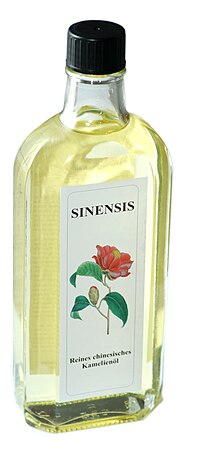
Photo from wikipedia
BackgroundCold tolerance is a key determinant of the geographical distribution range of a plant species and crop production. Cold acclimation can enhance freezing-tolerance of plant species through a period of… Click to show full abstract
BackgroundCold tolerance is a key determinant of the geographical distribution range of a plant species and crop production. Cold acclimation can enhance freezing-tolerance of plant species through a period of exposure to low nonfreezing temperatures. As a subtropical evergreen broadleaf plant, oil-tea camellia demonstrates a relatively strong tolerance to freezing temperatures. Moreover, wild oil-tea camellia is an essential genetic resource for the breeding of cultivated oil-tea camellia, one of the four major woody oil crops in the world. The aims of our study are to identify variations in transcriptomes of wild oil-tea camellia from different latitudes and elevations, and discover candidate genes for cold acclimation.ResultsLeaf transcriptomes were obtained of wild oil-tea camellia from different elevations in Lu and Jinggang Mountains, China. Huge amounts of simple sequence repeats (SSRs), single-nucleotide polymorphisms (SNPs) and insertion/deletions (InDels) were identified. Based on SNPs, phylogenetic analysis was performed to detect genetic structure. Wild oil-tea camellia samples were genetically differentiated mainly between latitudes (between Lu and Jinggang Mountains) and then among elevations (within Lu or Jinggang Mountain). Gene expression patterns of wild oil-tea camellia samples were compared among different air temperatures, and differentially expressed genes (DEGs) were discovered. When air temperatures were below 10 °C, gene expression patterns changed dramatically and majority of the DEGs were up-regulated at low temperatures. More DEGs concerned with cold acclimation were detected at 2 °C than at 5 °C, and a putative C-repeat binding factor (CBF) gene was significantly up-regulated only at 2 °C, suggesting a stronger cold stress at 2 °C. We developed a new method for identifying significant functional groups of DEGs. Among the DEGs, transmembrane transporter genes were found to be predominant and many of them encoded transmembrane sugar transporters.ConclusionsOur study provides one of the largest transcriptome dataset in the genus Camellia. Wild oil-tea camellia populations were genetically differentiated between latitudes. It may undergo cold acclimation when air temperatures are below 10 °C. Candidate genes for cold acclimation may be predominantly involved in transmembrane transporter activities.
Journal Title: BMC Genomics
Year Published: 2017
Link to full text (if available)
Share on Social Media: Sign Up to like & get
recommendations!